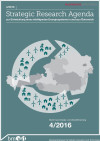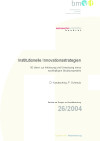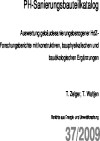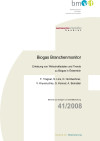Suchergebnisse für "Factsheet: Energietechnologien gestalten, die für alle sinnvoll und nutzbar sind"
Film "Bauen mit Hausverstand - Das Haus der Zukunft"

Dokumentation über ambitionierte Pilotprojekte vom ersten Spatenstich bis zur Fertigstellung
Mehrsprachig
IEA Bioenergy: Österreich Newsletter November 2021

In der vierten Ausgabe des IEA Bioenergy Österreich Newsletters werden Highlights aus den österreichischen Beteiligungen an den Tasks des IEA Bioenergy Netzwerkes vorgestellt. Neben diesen Highlights werden ausgewählte Projekte, Veröffentlichungen und Veranstaltungen präsentiert.
Herausgeber: Österreichische Taskdelegierte des IEA Bioenergy TCPs
Deutsch, 17 Seiten
Kick-Off Event zum Blue Award 09
10. Nov 2009
Kuppelsaal, Technische Universität Wien, Karlsplatz 13
1040 Wien, AT
Nachhaltigkeit in der Architekturausbildung
IEA HPP Annex 32: Heating and Cooling for Low Energy Houses
20. November 2007, 14:00 - 16:30 Uhr
TU Graz - Hörsaal i6, Inffeldgasse 25/D, Graz
Themendialog "Sommerkomfort - innovative Gebäudekonzepte"
20. Juni 2011
Kammer der Architekten und Ingenieurkonsulenten, Karlsgasse 9
1040 Wien, AT
Dieses Themenspektrum wird bei der Veranstaltung in vier Fachvorträgen beleuchtet.
Workshop: ECODESIGN radikal
22. Okt 2008
Hotel Paradies, Straßganger Straße 380b
8054 Graz, AT
Innovation durch öko-intelligente Produkte
IEA EBC Annex 61 Subtask C Report: Deep Energy Retrofit Pilot Projects (2017)

Der Bericht gibt einen Überblick über 7 umgesetzte Sanierungsprojekte in den Teilnehmerländern bei denen hochwertige Sanierungsmaßnahmen in Kombination mit innovativen Geschäftsmodellen umgesetzt wurden.
Cyrus Nasseri, Lohse Rüdiger, et al.
Herausgeber: New Buildings Institute (NBI)
Englisch, 132 Seiten
Downloads zur Publikation
Technical Report "Integrated Biogas Systems" (2018)

Applikationen der Biogastechnologie im Hinblick auf Nachhaltigkeit.
Bernadette McCabe und Thomas Schmidt
Herausgeber: IEA Bioenergie Task 37
Englisch, 28 Seiten
IEA PVPS Newsletter 2016

Schwerpunktthema des Newsletters ist eine Übersicht über jüngste Publikationen des IEA PVPS Programmes.
Gaetan Masson
Herausgeber: IEA PVPS Task 1 Chair
Englisch
Downloads zur Publikation
IEA Bioenergy Österreich Newsletter Juli 2024

In der neunten Ausgabe des IEA Bioenergy Österreich Newsletters werden wie gewohnt Highlights aus den österreichischen Beteiligungen an den Tasks des IEA Bioenergy Netzwerkes vorgestellt. Zusätzliche Informationen betreffen ausgewählte Projekte, Veröffentlichungen und Veranstaltungen.
Österreichische Taskdelegierte des IEA Bioenergy TCPs
Herausgeber: IEA Bioenergy TCP (Deutsch/Englisch, 2024)
Mehrsprachig, 14 Seiten
Downloads zur Publikation
Stakeholderdialog Biobased Industry: Ressourceneffiziente Bioraffinerie – Konversion von Sekundärrohstoffen
Am 7. Dezember werden wieder aktuelle Forschungs-und Entwicklungsaktivitäten im Themenfeld Biobasierte Industrie aus der FTI-Initiative "Produktion der Zukunft" und dem Biobased Industries (BBI) Joint Undertaking präsentiert.
Strategic Research Agenda

zur Entwicklung eines intelligenten Energiesystems in und aus Österreich
Schriftenreihe
4 /2016
Herausgeber: BMVIT
Deutsch, 98 Seiten
Downloads zur Publikation
DI (FH) Volker Schaffler, MA
LehB:KlimafitDemo2+1 - Living in existing buildings today: climate-friendly renovations in existing buildings within the framework of the common good housing law
The LehB:KlimafitDemo2+1 project examines innovative renovation solutions for the climate-fit modernization of non-profit residential buildings without placing a financial burden on tenants. By implementing a flexible modular system and involving the residents, economic, technical and social aspects of the renovation are optimized. The aim is to make an important contribution to achieving climate neutrality by 2040 through adapted measures and comprehensive monitoring.
Netzqualität bei dezentraler Stromeinspeisung auf Basis erneuerbarer Energieträger
Durch den Einsatz neuer Technologien integriert in dezentrale Stromerzeugungsanlagen basierend auf erneuerbaren Energieträgern soll demonstriert werden, wie diese aktiv zur Verbesserung der Versorgungsqualität in Netzen beitragen können, um damit den weiteren Ausbau von dezentraler Erzeugung zu unterstützen.
Fachtagung: Integrierte Managementmodelle - zukunftsfähige Methoden zur Steigerung des Unternehmenswertes
21. Jun 2004
Wirtschaftskammer Wien Wien, AT
Institutionelle Innovationsstrategien

60 Ideen zur Initiierung und Umsetzung eines nachhaltigen Strukturwandels
Schriftenreihe
26/2004
D. Kanatschnig, P. Schmutz
Deutsch, 86 Seiten
Downloads zur Publikation
PH-Sanierungsbauteilkatalog

Auswertung gebäudesanierungsbezogener HdZForschungsberichte mit konstruktiven, bauphysikalischen und bauökologischen Ergänzungen
Schriftenreihe
37/2009
T. Zelger, T. Waltjen
Herausgeber: BMVIT
Deutsch, 249 Seiten
Downloads zur Publikation
Biogas Branchenmonitor

Erhebung von Wirtschaftsdaten und Trends zu Biogas in Österreich
Schriftenreihe
41/2008
F. Tragner, S. Lins, D. Hornbachner, V. Kryvoruchko, G. Konrad, A. Bomatter
Herausgeber: BMVIT
Deutsch, 128 Seiten
Downloads zur Publikation
10., Rothneusiedl - climate model district Rothneusiedl: Preparation for the planned EU mission "New European Bauhaus"
Rothneusiedl will become a pioneering district for climate protection, climate adaptation and the circular economy. The existing RothNEUsiedl Charter outlines nine principles for making the district climate-friendly and inclusive. The dialogical and integrated process involves various target groups, including the planning and construction industry, future residents and businesses, in order to establish a local building culture at an early stage. NEB working principles are applied in order to support the parallel mission statement process.
